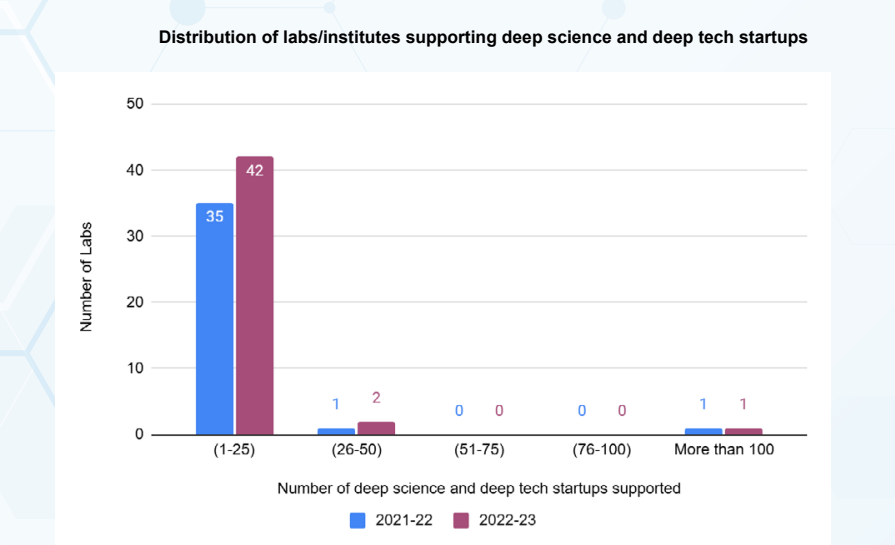Facts for UPSC Mains
India's Struggles with Supporting Deep-Tech Startups
- 01 May 2025
- 9 min read
Why in News?
A study commissioned by the Office of the Principal Scientific Advisor (PSA) has revealed that India's public-funded Research and development (R&D) ecosystem offers limited support to deep-tech start-ups.
What is Deep Tech?
- About: It refers to technology based on significant scientific or engineering advancements, often requiring extensive research and development.
- Examples of Deep Tech include AI, quantum computing, biotechnology, and robotics. These innovations address complex problems and have the potential to drive major economic and societal changes.
- India’s Initiatives Related to Deep Tech:
What are the Key Findings of the Study on R&D Organizations' Support for Startups?
- Limited Support for Deep Tech Start-Ups: Only 1 in 4 public-funded R&D organizations provide incubation support for start-ups, and just 1 in 6 focus on deep-tech startups.
- Only 15% of the institutions collaborated with foreign industry partners, limiting global exposure and technology co-development.
- Low External Collaboration: 50% of labs do not open their facilities to external researchers or students, limiting cross-pollination of ideas and knowledge-sharing.
- Skewed Budget Utilization: Central government expenditure on R&D was Rs 55,685 crore in 2020-21, but when excluding strategic sectors (defence, space, atomic energy), the spending on non-strategic sectors amounted to Rs 24,587 crore.
- Only one-fourth of participating institutions spent 75–100% of their budget on actual R&D activities.
- Many labs under the Council of Scientific and Industrial Research (CSIR), Indian Council of Medical Research (ICMR), Ministry of AYUSH, and Department of Science and Technology (DST) reported R&D spending below the median level.
Why Does India Struggle to Support Deep Tech Start-Ups?
- Skewed Focus on Low-Tech Consumer Services: The majority of Indian start-ups cater to consumer-facing sectors such as food delivery, logistics, and fintech.
- This trend is driven by short-term profitability and low entry barriers, in contrast to the capital-intensive and high-risk nature of deep tech areas like semiconductors, robotics, and space tech.
- Venture capital in India heavily favours fast-scaling sectors like e-commerce, edu-tech, and digital payments.
- Underwhelming R&D Investment: India’s gross expenditure on R&D is only 0.64% of GDP, far below global leaders like China (2.43%).
- Most of this spending is concentrated in strategic sectors (defence, space, atomic energy) that are not accessible to private start-ups, restricting innovation spillovers.
- Lack of Risk-Tolerant Capital: Deep-tech ventures often operate in pre-revenue stages for extended periods due to the complexity of their technologies. They need substantial upfront investment in lab facilities, Intellectual Property protection, and a skilled workforce.
- Lack of predictable, long-term funding deters entrepreneurs from entering high-risk, high-reward sectors like AI, semiconductors, and space tech.
- The Startup India Seed Fund and other schemes provide early-stage funding, but fail to meet the sustained capital needs of deep-tech ventures.
- Insufficient Institutional Collaboration: A lack of robust industry-academic partnerships leads to gaps in applying research outcomes to real-world solutions, particularly in emerging technologies like AI, quantum computing, and biotechnology.
- The absence of industry collaboration limits the ability of research labs to develop scalable and market-ready innovations.
- Infrastructure Bottlenecks: Many of India’s public-funded R&D labs lack the facilities necessary for incubating and nurturing deep-tech start-ups.
- High-tech startups often require reliable digital infrastructure, energy, and lab access, which remain limited in Tier II and III cities, where most new startups are emerging.
- Brain Drain of Research Talent: Due to the underfunded and less conducive ecosystem in India, many talented researchers in fields like AI, robotics, and semiconductors opt to move to countries like the US and Europe, where opportunities and funding are more readily available.
- Additionally, the lack of advanced skills in emerging technologies like quantum computing and AI, further weakens the deep-tech ecosystem.
- Policy and Regulatory Complexity: In 2024, the IndiaAI Mission was approved to promote indigenous AI capabilities. However, it wasn't until 2025 that the government selected Bengaluru-based startup Sarvam to develop India's first homegrown Large Language Model (LLM).
- This decision was largely reactive to China's rapid AI advancements, highlighting India's delayed recognition of deep-tech sectors like AI as crucial for national innovation and digital sovereignty.
- Additionally, India lacks a dedicated compliance framework tailored for deep-tech ventures. Navigating bureaucratic red tape, securing intellectual property, and accessing lab facilities remain challenging, discouraging serious investment in innovation.
|
Drishti Mains Question: Analyze the challenges faced by deep-tech startups in India and the role of public-funded research and development organizations in supporting them. |
| Read more: India's Startup Ecosystem |
UPSC Civil Services Examination Previous Year Questions (PYQ)
Q. What does venture capital mean? (2014)
(a) A short-term capital provided to industries
(b) A long-term start-up capital provided to new entrepreneurs
(c) Funds provided to industries at times of incurring losses
(d) Funds provided for replacement and renovation of industries
Ans: (b)
Q. When the alarm of your smartphone rings in the morning, you wake up and tap it to stop the alarm which causes your geyser to be switched on automatically. The smart mirror in your bathroom shows the day’s weather and also indicates the level of water in your overhead tank. After you take some groceries from your refrigerator for making breakfast, it recognises the shortage of stock in it and places an order for the supply of fresh grocery items. When you step out of your house and lock the door, all lights, fans, geysers and AC machines get switched off automatically. On your way to office, your car warns you about traffic congestion ahead and suggests an alternative route, and if you are late for a meeting, it sends a message to your office accordingly. (2018)
In the context of emerging communication technologies, which one of the following terms best applies to the above scenario?
(a) Border Gateway Protocol
(b) Internet of Things
(c) Internet Protocol
(d) Virtual Private Network
Ans: (b)







